The new iPad: Retina Display Analysis
by Anand Lal Shimpi on March 19, 2012 5:49 PM ESTQuantifying Display Performance: Big Gamut Gains
Pixel density may have improved, but what about the rest of the display characteristics? We'll start with the usual suspects - brightness, black levels and contrast ratio:
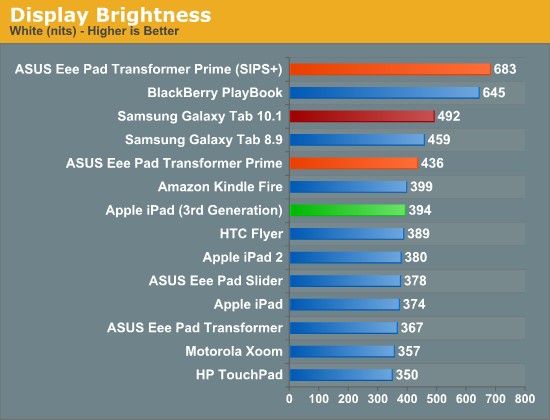
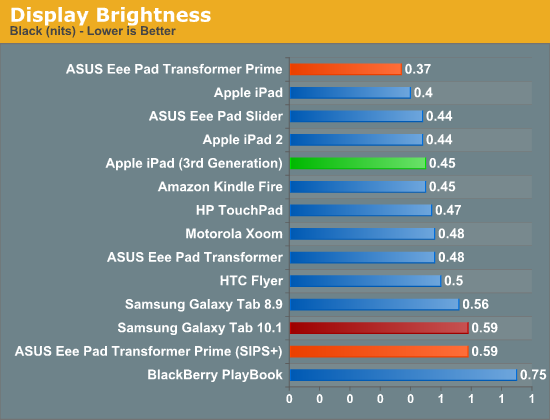
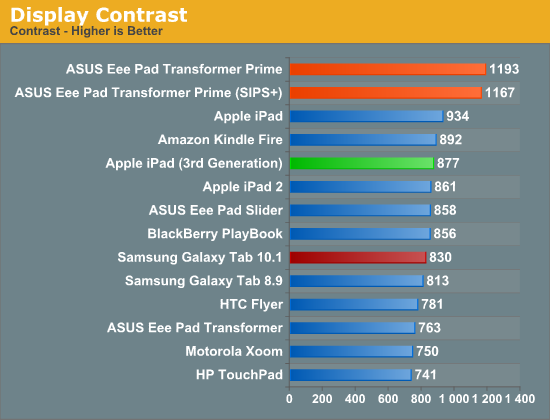
Despite a tremendous increase in pixel count and density, the new iPad delivers roughly the same brightness and contrast ratio as its predecessor. White point remains unchanged as well at ~6700K.
At the introduction of the new iPad, Apple briefly mentioned a 44% increase in color saturation from the new panel. Although the old display definitely looked good, the new one does actually look better. My eyes aren't normally the best judge of gamut, but we have some tools to help quantify exactly what I was seeing:
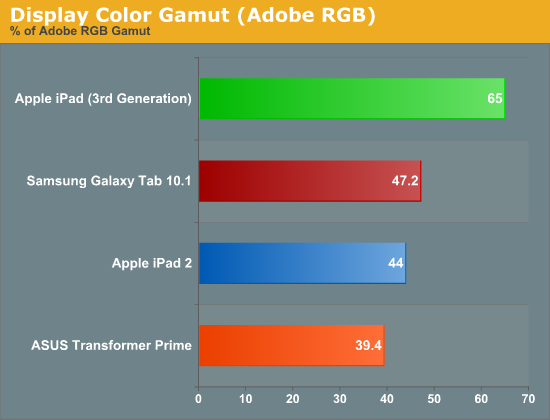
Color gamut has definitely improved. While the iPad 2 and TF Prime both were able to represent ~40% of the Adobe RGB color gamut, the new iPad jumps by nearly 50% to representing 65% of the Adobe RGB gamut. More impressive are the gains you see if you look at the color gamut of the new panel compared to the sRGB space:
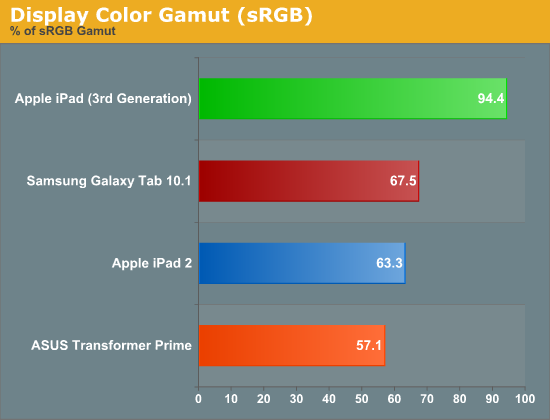
Here the panel is able to deliver nearly full coverage of the sRGB color gamut. Below is the CIE diagram for the new panel with an sRGB reference plotted on the same chart so you can visualize the data another way (the white triangle is the new iPad, the gray outer triangle is the sRGB reference):
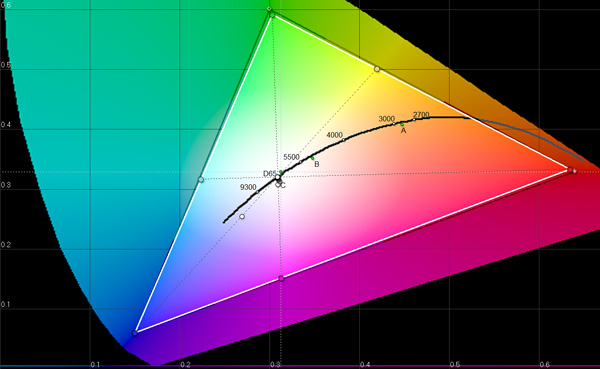
Near perfect coverage. The new iPad's display is a huge step forward in both pixel density and being able to represent a wider color gamut. While it's still no where near the quality of high-end PC displays, this is real progress for tablets. The bar has been raised.
















172 Comments
View All Comments
name99 - Tuesday, March 20, 2012 - link
I hate to have to point out the obvious but you've said something REALLY stupid here.PDFs are not "terrible" on iPads. It's just that iBooks is a crappy PDF reader.
Go to the App Store. Type in PDF Reader. You will see a hundred different possibilities, pretty much all of which allow you to crop PDFs. Personally I think GoodReader is the best because of its various synchronization abilities and its hierarchical filing system, but there are plenty of alternatives and even the free options are not too bad.
svojoe - Tuesday, March 20, 2012 - link
I'm really happy to see pixel densities increasing. But really this is not revolutionary... my 4 year old HTC FUZE smart phone had a 2.8" screen, and a 640x480 resolution. I think that is 288PPI.Which would mean, its pixel density is 'higher' than the IP3. Its not as if this is 'amazing' innovation to me. However its nice because I've been thoroughly saddened by pixel counts dropping for the last 6 years.
name99 - Tuesday, March 20, 2012 - link
(a) No-one is calling it revolutionary. They are calling it a really nice screen for a tablet.(b) It's a TABLET-SIZED screen, not a 2.8" screen. The fact that people could make SMALLER high-res screens years ago is not a secret.
You're acting like someone who sees that you can now buy a thin LCD 46" TV for $500 and says "So what, we had color TVs thirty years. Admittedly they cost a fortune, and had a smaller screen, and weighed a ton, and were three feet deep, but they displayed TV and that's all that really matters".
svojoe - Wednesday, March 21, 2012 - link
Maybe you have not caught some of the hype over the ip3. I've heard people call the new screen "a huge leap forward", "magical clarity", etc etc. Maybe I am a bit put off by all this hoop-la. I haven't even seen one yet, but I'm sure its really amazing levels of detail. And that is good. In this instance I want to applaud apple for raising the bar. Because it has falling oh, so low the last several years when it comes to resolution and PPI.Taurus229 - Tuesday, March 20, 2012 - link
Brightness is OK, pixel count makes it shine !!!!!!! Goodbye Metro and Windows 8 !!!!!!!! Maybe now, Microsoft won't put all their eggs in one basket, and ignore corporate and desktop users.ffletchs - Tuesday, March 20, 2012 - link
you left out the best tablet display yet, Samsung Galaxy Tab 7.7, the only tablet with Super AMOLED+ displaytrane - Wednesday, March 21, 2012 - link
In my opinion, the pixels per inch doesn't count for anything until you account for viewing distance.Consider iPhone and iPad, they call it a Retina display despite a lower PPI versus iPhone simply because people are looking at their tablets from further away than their phones.
The iPad may have a 2.5x higher PPI than the 30 inch display, but you are looking at your iPad from 12-18 inches away, while a 30 inch display will need a 4-5 feet viewing distance. The iPad will certainly be 2.5x sharper than the 30 inch Cinema Display at the same viewing distance, but who looks at a 30 inch display from 1 feet out?! In fact, most people watch 32 inch HDTVs from as far as 10 feet away. So viewing distance must be accounted for.
rakez - Wednesday, March 21, 2012 - link
sorry i still prefer widescreen. yes, even for my tablets.Lucian Armasu - Wednesday, March 21, 2012 - link
It seems the new Galaxy Tab 7.7 with a 5,100 kills the new iPad in battery efficiency, even though it has a more than twice as big battery at ~12,000 mAh. And it still manages to get around 200 PPI but on a Super AMOLED Plus display, which is preferable to any IPS display in my opinion.doobydoo - Thursday, March 22, 2012 - link
It has a far smaller screen, much lower resolution, massively inferior GPU. It's no surprise that it can last longer. The 200 PPI is less useful given that typical users will hold it closer than the larger ~10 inch tablets.It's also more expensive than the new iPad in the UK.